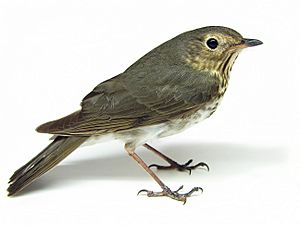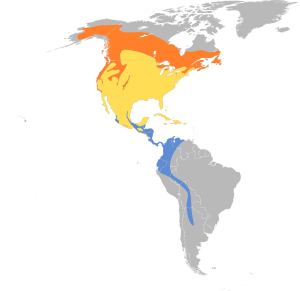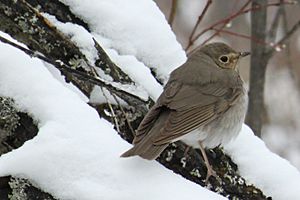Swainson's thrush facts for kids
Quick facts for kids Swainson's thrush |
|
|---|---|
 |
|
| Conservation status | |
| Scientific classification | |
| Genus: |
Catharus
|
| Species: |
ustulatus
|
 |
|
| Synonyms | |
|
Hylocichla swainsonii |
|
The Swainson's thrush (Catharus ustulatus) is a medium-sized bird. It is also known as the olive-backed thrush. This bird is part of the Catharus genus. It is known for its quiet colors and beautiful, flute-like song. The Swainson's thrush was named after William Swainson. He was an English ornithologist, someone who studies birds.
Contents
What's in a Name?
The genus name Catharus comes from Ancient Greek. It means "pure or clean." This name refers to the feathers of another bird, the orange-billed nightingale-thrush. The second part of the name, ustulatus, is Latin. It means "burnt," from the word urere, which means "to burn." This might describe the bird's brownish color.
Where Do They Live?
Swainson's thrushes breed in coniferous forests. These are forests with trees like pines and spruces. They like areas with thick bushes underneath. You can find them across Canada, Alaska, and the northern United States. They also live in deciduous forests along the Pacific coast of North America. Deciduous forests have trees that lose their leaves in the fall.
Their Travels and Homes
These birds are migratory. This means they travel long distances. They fly south for the winter. Some go to southern Mexico and as far as Argentina.
Birds from the Pacific coast fly down the coast of North America. They spend winter from Mexico to Costa Rica. Birds from the middle of the continent fly east first. Then they travel south through Florida. They winter from Panama to Bolivia.
Sometimes, a Swainson's thrush might fly off course. They have been seen rarely in western Europe. They have also appeared in northeast Asia.
What Threats Do They Face?
Sometimes, the hermit thrush might take over areas where Swainson's thrushes live. This happens when their homes overlap. The hermit thrush might be better at living near people. Swainson's thrushes tend to stay away from places where humans build things or are very active. This is especially true in their winter homes.
What Do They Look Like?
Swainson's thrushes are about 16–20 cm (6.3–7.9 in) long. Their wingspan is usually about 30 cm (12 in). Their bill is about 1.5–1.9 cm (0.59–0.75 in) long. These birds weigh between 23 to 45 g (0.81 to 1.59 oz).
They have a special white-dark-white pattern under their wings. This pattern is common for Catharus thrushes. Their upper parts are brown. Their undersides are white, with brown on their sides. Their chest is a lighter brown with darker spots. They have pink legs and a light brown ring around their eyes.
Birds in the eastern parts of their range are more olive-brown. Western birds are more reddish-brown. Their song sounds like a fast series of flute-like notes. The song spirals upwards.
What Do They Eat?
Swainson's thrushes look for food on the forest floor. They also find food in trees. They mainly eat insects, fruits, and berries. They build their nests in the shape of a cup. They place these nests on horizontal tree branches.
Different Types of Swainson's Thrush
There are four known types, or subspecies, of Swainson's thrush. These are Cathartus ustulatus alame, C. u. swainsoni, C. u. ustulatus, and C. u. oedicus.
The alame and swainsoni subspecies spend their summers east of the British Columbian Coast Mountains, the Cascades, and the Sierra Nevada. The ustulatus and oedicus subspecies spend their summers west of these mountains. There is a small area in the Coast Mountains where both groups can be found.
Scientists have studied their genes. They found that these two pairs of subspecies are different groups. They split apart a long time ago, about 10,000 years ago. This was when the last ice age was ending. Habitats across North America were changing.
The differences in their genes and their long migration routes suggest something interesting. After the last ice age, these birds quickly spread out. Populations that used to spend summers in the southeast of North America moved north and west as the ice melted. The way continental birds migrate today, especially those in the west, isn't the easiest route. It's likely an old route they inherited. They haven't changed it to fit their current homes.
See also
 In Spanish: Zorzalito de Swainson para niños
In Spanish: Zorzalito de Swainson para niños




